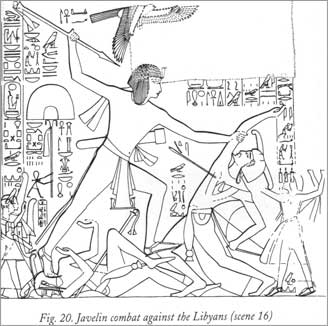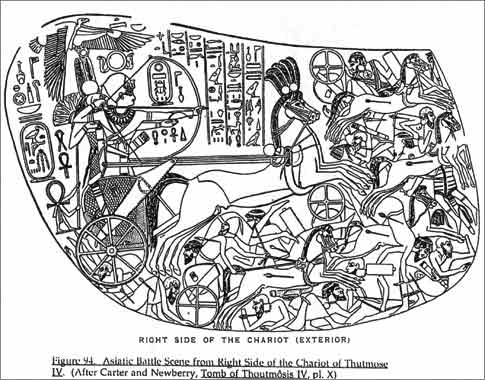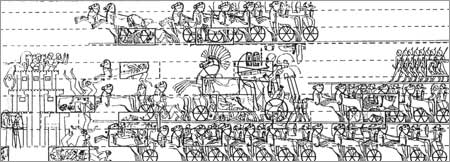| Contents > “Silent Partners”. The Horse and Chariot and the Image of the King by Susan Turner |
| Page 1 | 2 | 3 | 4 | 5 |
This is what is contained in them.

( Figure 5. Schwaller de Lubicz. 1999: 561)

( Figure 6. Harvey.1998: 547)
In both, the king is the largest figure and the centre of the action. He is beating down his enemies through his own personal efforts. He is fit, strong, aggressive, seemingly skilful, brave, young and active. The scene as a whole is dramatic and filled with sound and fury but it shows a king on the ground, on the same surface as both his enemies and his own forces. He is strong and kingly but he is one individual among many and his power is very personal. The focus is narrow and tells only the immediate part of the story and it is confined to one place. Compare it to the image of Thutmose 1V. The horse and chariot lift the king above the action; he is now well above all other combatants. Together with the king the horses and chariot are shown on a much larger scale than any other and the combination enables the king’s image to dominate the scene even more effectively. He is still fit, strong, aggressive, skilful, brave, young and active but now he is charging into battle at great speed aboard an amazing vehicle with the reins of two huge powerful stallions tied around his waist and is able because of the scale difference to crush proportionally more enemies under the feet of his horses. The dramatic action has been enhanced tremendously. The prestige of possessing horses, their nobility and raw natural power and energy has attached to the king and enhanced his image as conqueror. The “flying gallop” posture of the horses (an image which appears to owe much to Minoan influence) exudes power and speed. The magnificent chariot and harnesses of the horses contribute more colour and also a clear statement about the king’s possession of the newest technological innovations and his enhanced mobility. This is a much more impressive and indeed exciting scene.
Ray Johnson has reconstructed an Asiatic scene from Thebes depicting Tutankhamun in battle. ( Johnson. 1992: 188) In this more traditional elements are mixed with the new when an Asiatic city is attacked by the massed chariot regiments of the king whose horses trample the enemy underfoot and whose massed chariot warriors attack and defeat a walled city. The Egyptians developed the new type of image and embarked on dramatic narrative beyond what was achieved in the past and enabled the image to embrace the whole event, which as a result takes on epic proportions.

( Figure 7. Johnson.1992:188)
The various kings of Egypt may not have maintained Maat in reality - but with the use of images like this, those who viewed them were persuaded that they did. Horses and chariots were silent partners in creating the reality and the perception of the power of the king in ancient Egypt.
| Page 1 | 2 | 3 | 4 | 5 |
| Contents > “Silent Partners”. The Horse and Chariot and the Image of the King by Susan Turner |
